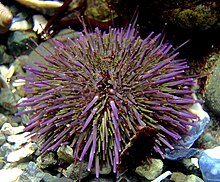| Strongylocentrotus purpuratus | |
|---|---|
 |
|
| Scientific classification | |
| Kingdom: | Animalia |
| Phylum: | Echinodermata |
| Class: | Echinoidea |
| Subclass: | Euechinoidea |
| Superorder: | Echinacea |
| Order: | Echinoida |
| Family: | Strongylocentrotidae |
| Genus: | Strongylocentrotus |
| Species: | S. purpuratus |
| Binomial name | |
| Strongylocentrotus purpuratus | |
The purple sea urchin, Strongylocentrotus purpuratus, lives along the eastern edge of the Pacific Ocean extending from Ensenada, Mexico to British Columbia, Canada.[1] This sea urchin species is deep purple in color and lives in lower intertidal and nearshore subtidal communities. Along with sea otters and abalones, it is a prominent member of the spectacular kelp forest community.[2] It normally grows to a diameter of about 4 inches and it may live as long as 70 years.[3]
The purple sea urchin plays many roles.[4] Besides its ecological importance, it is also an important fishery along the west coast of the US[5] and it is one of several biomedical research models in cell and developmental biology.[6]
Because of its importance to biomedical research, the sea urchin genome was completely sequenced and annotated in 2006.[7] The sea urchin genome is estimated to encode about 23,300 genes. Many of these genes were previously thought to be vertebrate innovations or were only known from groups outside the deuterostomes. Thus the sea urchin genome provides a comparison to our own and those of other deuterostomes, the larger group to which both echinoderms and humans belong.[7] Using the strictest measure, the purple sea urchin and humans share 7,700 genes.[8] Many of these genes are involved in sensing the environment,[9] a fact surprising for an animal lacking a head structure.
http://en.wikipedia.org/wiki/Purple_sea_urchin




